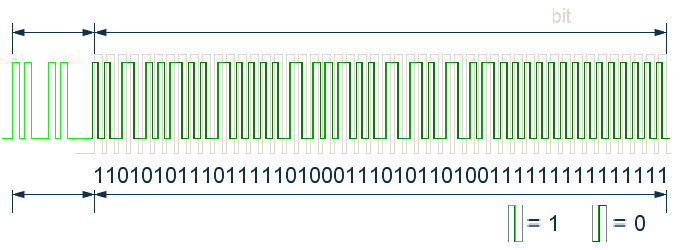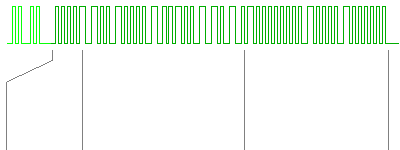Mode S Reply Encoding

Figure 1: Mode S - pulse position modulation (PPM)

Figure 1: Mode S - pulse position modulation (PPM)

Figure 1: Mode S - pulse position modulation (PPM)
Mode S Reply Encoding
Mode S replies consists of a certain number of pulses at a 1 µs spacing. (The bit update rate allows a 1 µs per data bit transfer rate that can be translated to a one megabit per second data rate.) The Mode S reply consists of two distinct parts:
- a preamble and
- a data block.
Pulse position modulation is a form of signal modulation in which the data information is encoded in the time delay between pulses in a sequence of signal pulses.

number
control
(parity)
Figure 2: Content of the short messages data block

number
control
(parity)
Figure 2: Content of the short messages data block

number
control
(parity)
Figure 2: Content of the short messages data block
Preamble
Every Mode S reply starts with a preamble with a length of 8 microseconds. The pattern of the preamble consists of four pulses with a length of 0.5 microseconds per pulse. The interspaces (to the first pulse) are 1; 3.5 and 4.5 microseconds.
Data block
The data block consists of either 56 or 112 bits with a length of either 56 or 112 microseconds. The short data block format is divided in a format identifier of 5 bits, a surveillance and control word of 27 bits and the 24 bits for the individual airplane code including a parity information.
| Downlink format | message format | Content |
|---|---|---|
| DF0 | Fig. 2 | Short Air to Air ACAS |
| DF4 | Fig. 2 | Surveillance (roll call) Altitude |
| DF5 | Fig. 2 | Surveillance (roll call) IDENT Reply |
| DF11 | Fig. 2 | Mode S Only All-Call Reply (Acq. Squitter if II=0) |
| DF16 | Fig. 3 | Long Air to Air ACAS |
| DF17 | Fig. 3 | 1090 Extended Squitter |
| DF18 | Fig. 3 | 1090 Extended Squitter, supplementary |
| DF19 | Military Extended Squitter | |
| DF20 DF21 | Fig. 3 | Comm. B Altitude, IDENT Reply |
| DF22 | Military use only | |
| DF24 | Fig. 4 | Comm. D Extended Length Message (ELM) |
Table 1: Mode S Downlink format numbers
The longer downlink formats using 112 bit length of data block can exhibit an additional message field of 56 bits, or an extended length message field of 80 bits. All messages content the airplanes identification number including a parity information in co-operation with the surveillance and communication control word.
The format number defines 25 coding formats. Each Mode S downlink format has a particular purpose. The formats DF0, DF4, DF5, DF11, DF16, DF20, DF21 and DF24 are used in civil aviation at present. The format DF0 provides informations for ACAS. The DF17 format is used for the ADS-B system.
Replies with the DF0 format are responses to ACAS or TCAS interrogations. Downlink format 16’s are transmissions which are used by ACAS or TCAS units to communicate between aircraft. The responses for ground based interrogations have the DF4 format. DF11 and DF17 are “squittered” by Mode S transponders at a nominal rate of 1 Hz.

number
control
(parity)
Figure 3: Content of the long messages data block (communication reply)

number
control
(parity)
Figure 3: Content of the long messages data block (communication reply)

number
control
(parity)
Figure 3: Content of the long messages data block (communication reply)

number
control
(parity)
Figure 4: Content of an extended length message data block (communication reply)

number
control
(parity)
Figure 4: Content of an extended length message data block (communication reply)

number
control
(parity)
Figure 4: Content of an extended length message data block (communication reply)
The downlink format DF24 is the one and only format number beginning with two High-bits and contains an extended length message data block. The decoder need to examinate these two bits only for reading this format number. The amount of bits can be shorten in the format number block therefore, as shown in Figure 4.
